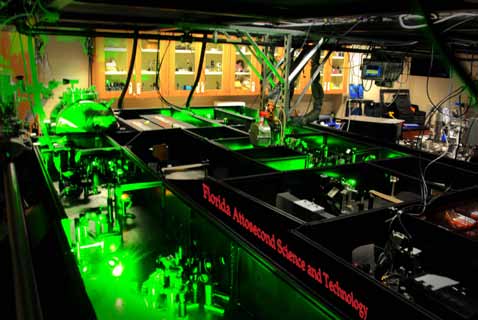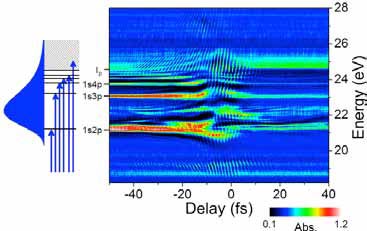The quest for the shortest attosecond laser pulse has been underway since the first demonstration of such light sources in 2001. Single attosecond pulses with a record duration of 80 as were previously generated in 2008. Further reduction of the pulse width requires a broader spectrum with correct phase. The extreme ultraviolet (XUV) continuum produced by the Double Optical Gating (DOG) developed by Professor Zenghu Chang’s group covers much broader spectra than the previous scheme. They demonstrated that the XUV light could be tailored to obtain the spectrum with the desirable phase. In addition, they solved the characterization problem by improving a scheme named PROOF (Phase Retrieval by Omega Oscillation Filtering) previously developed in his group. A 67 attosecond XUV pulse, the new shortest light pulse world record, was generated and f fully characterized by PROOF in 2012.
Understanding and controlling the dynamic evolution of electrons in matter is among the most fundamental goals of attosecond science. Chang’s group developed an advanced attosecond transient absorption setup at UCF, with which they obtained ground-breaking results in observing excited electronic state dynamics of atoms with sub-optical cycle time resolution. They have been able to show that the concepts of dynamic Stark shift and ponderomotive energy shifts, which are intrinsically cycle averaged quantities used routinely in the literature for decades, have to be extended to include subcycle structure on the time scale of the near infrared dressing field.
They uncovered absorption structures corresponding to laser-induced “virtual” intermediate states in the two-color twophoton and three-photon absorption process. These previously unobserved absorption structures are modulated on half-cycle (~1.3 fs) and quarter-cycle (~0.6 fs) timescales, resulting from quantum interference. The results were published in Physical Review Letters and Scientific Reports in 2013.


Dr. Chang led a research team that received a $6.9 million grant from the U.S. Defense Advanced Research Projects Agency to make those pulses 1000 times stronger. The team is comprised of researchers from the University of Ottawa (Professor Paul Corkum) and the University of California, Berkeley (Professors Steve Leon and Dan Neumark) to help the federal agency better understand the interaction of electrons in solids and, ultimately, create ultrafast sensors and detectors. There is also a strong interest in investigating whether attosecond pulses of laser light can be applied to building electronic devices with much greater speeds. The new attosecond light source to be built will be strong enough to both excite and probe electron dynamics, which is considered to be the Holy Grail of attosecond science.
The first stage of the project will focus in building a new femtosecond laser capable of producing higher energy, pulses to drive the process of attosecond pulse generation. The laser will be housed in a 2400 square-foot space comparable to four standard labs in UCF’s Physical Science buildingand still, the laser beam will have to be “folded” multiple times to achieve the power the DARPA project is seeking. Such a facility will help the U.S. compete more effectively with European countries that have thus far dominated the landscape for attosecond laser research infrastructure.
Chang has a joint appointment in the College of Optics and Photonics and the Department of Physics, and is also the the Director of the UCF new Institute for the Frontier of Attosecond Science and Technology (iFAST), which has researchers from the Department of Physics and CREOL. iFAST has the potential to create major breakthroughs in our understanding of the role of ultrafast electron dynamics.
Chang was elected as a Fellow of the Optical Society of America in 2013. He is also a Fellow of American Physical Society.